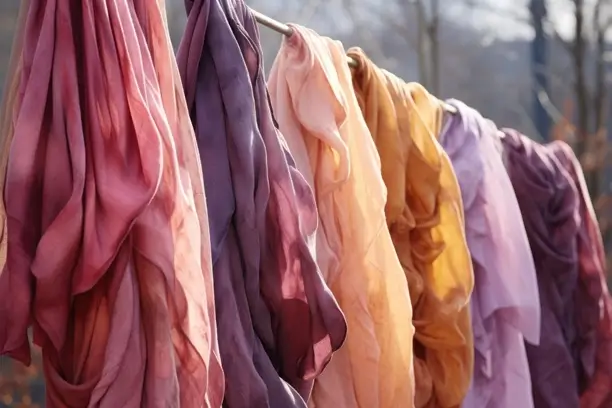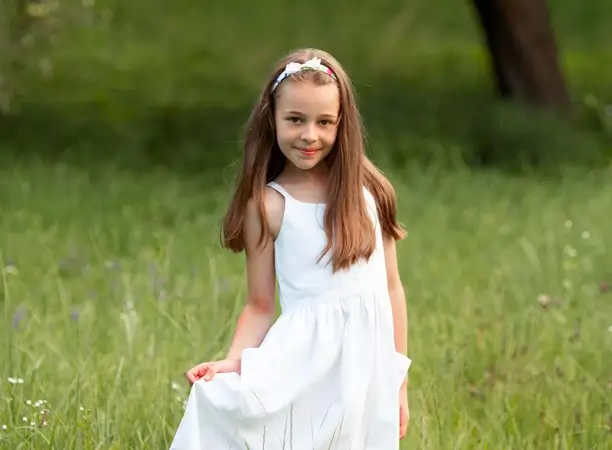In the world of fashion, few fabrics evoke the same sense of grace and sophistication as chiffon. Delicate and ethereal, chiffon has become synonymous with elegance and femininity. Its sheer beauty and flowing nature make it a popular choice for creating stunning garments that exude an air of romance. But what exactly is chiffon, and what sets it apart from other fabrics?

What Is Chiffon Fabric?
Chiffon fabric is a lightweight and sheer material commonly used in the fashion industry. It can be made from silk, polyester, cotton, or a blend of synthetic and natural fibers together. Known for its delicate and flowing qualities, chiffon fabric is often used to create elegant and feminine garments.
How Is Chiffon Fabric Made?

Chiffon fabric can be made using different processes depending on the desired composition. Traditional chiffon is made from silk fibers through a plain weave technique, resulting in a lightweight and sheer fabric.
Modern production methods also involve weaving or knitting synthetic polyester fibers to create fine and slightly transparent nylon chiffon fabric.
What Does Chiffon Fabric Look Like?

Chiffon fabric has a distinct appearance that sets it apart from other fabrics. It is characterized by its lightweight and sheer nature, allowing light to pass through and creating a translucent effect. Chiffon has a delicate and ethereal look, often with a slightly crinkled texture that adds a subtle depth to the floating appearance of the fabric.
The fabric used to make chiffon has a matte finish with a soft and subtle sheen, giving it a graceful and elegant appearance. It drapes beautifully and has a flowing quality, adding a sense of movement and fluidity to garments. Overall, chiffon fabric has a delicate and romantic aesthetic that enhances the femininity and elegance of the outfits and wedding dresses it is used for.
What Does Chiffon Feel Like?
Chiffon fabric has a unique and pleasant feel that is often described as soft, lightweight, and airy. When touched, chiffon feels smooth and silky against the skin, thanks to its fine and delicate fibers. It has a subtle texture that can vary depending on the specific type and finish of the chiffon. Chiffon’s lightweight nature contributes to its airy and floaty feel, making it comfortable to wear.
What Are the Characteristics of Chiffon?

Chiffon fabric possesses several distinct characteristics that set it apart:
- Lightweight and sheer: Chiffon is known for its airy and delicate nature, making it lightweight and translucent. It allows light to pass through, giving it a subtle ethereal quality.
- Soft and flowing: Chiffon has a soft and smooth texture that feels luxurious against the skin. Its fluid drape creates graceful movement when worn.
- Slightly crinkled texture: Chiffon fabric often features a slightly crinkled or textured surface, adding dimension and visual interest to garments.
- Versatile: Chiffon can be easily dyed, printed, or embellished, offering a wide range of design possibilities.
Chiffon fabric is commonly used in the fashion industry for a variety of purposes. Its lightweight and flowing nature make it a popular choice for creating elegant and feminine garments such as dresses, blouses, skirts, and eveningwear.
Chiffon’s sheer properties also make it suitable for layering, adding depth and dimension to outfits. It is often used as an overlay or as sleeves on tops and dresses to create a romantic and ethereal look.
Overall, chiffon exudes an elegant and romantic aesthetic, making it a very popular fabric choice for creating feminine and sophisticated garments and wedding dresses.
Where Is Chiffon Fabric Produced?

Chiffon fabric is produced in various countries around the world. Historically, chiffon was first introduced and popularized in France during the 18th century. However, today, chiffon production is not limited to one cloth or rag single region or country in the fashion world.
Many countries have their textile industries that produce chiffon curtains and similar fabric used. China, India, and South Korea are among the leading producers of chiffon globally. These countries have established textile manufacturing sectors and expertise in producing a wide range of fabrics, including silk chiffon displays.
What Are the Pros and Cons of Using Chiffon?

Pros:
- Lightweight and breathable: Chiffon fabric is incredibly light and airy, making it comfortable to wear, especially in warm weather.
- Delicate and ethereal appearance: Chiffon has a sheer and flowing quality that adds a touch of elegance and romance to garments.
- Versatile: Chiffon can be easily dyed, printed, or embellished, offering a wide range of design options and versatility in creating different looks.
- Drapes beautifully: Chiffon fabric has excellent draping qualities, creating a graceful and fluid movement when worn.
Cons:
- Wrinkling: Chiffon fabric tends to wrinkle easily and may require careful handling and maintenance to keep it looking smooth.
- Sheerness: The sheer nature of chiffon may require additional lining or layering for modesty or to achieve the desired level of coverage.
- Delicate care: Chiffon typically requires special care during washing and handling, often necessitating gentle washing methods or dry cleaning.
- Static cling: Chiffon can generate static electricity, causing the fabric to cling to the body or other garments, which may be uncomfortable or inconvenient.
Chiffon vs Silk

Chiffon and silk are both popular fabrics in the fashion industry, but they differ in their composition, characteristics, and uses.
Chiffon is a lightweight, sheer fabric made from silk, nylon, and polyester together, or synthetic fibers. It has a slightly crinkled texture and is known for its airy and flowing nature. Chiffon is often used to create delicate and feminine garments such as dresses, blouses, and scarves.
Silk, on the other hand, is a natural fabric made from silk fibers. It is highly valued for its luxurious feel, softness, and lustrous appearance. Silk is known for its excellent draping qualities and is used to create high-end garments, formal and other full, and for evening gowns and dresses, gowns and dresses, gowns and dresses, and elegant accessories. It has a smooth, silky texture that sets it apart from chiffon.
What is silk chiffon fabric?
Silk chiffon fabric or synthetic chiffon is a delicate and lightweight fabric made from silk fibers. It is a type of chiffon that specifically uses silk as its raw material. Silk chiffon combines the luxurious qualities and rough feel of silk with the sheer and flowing characteristics of chiffon.
Silk chiffon is known for its ethereal and graceful appearance. It has a slightly crinkled texture and sheer transparency that allows light to pass through, creating a soft and romantic effect. The fabric has a smooth and silky touch against the skin, making it comfortable to wear.
What is the difference between silk and silk chiffon?
The main difference between silk and silk chiffon lies in their weight, texture, and overall appearance. Silk is made from a natural fabric derived from silk fibers, known for its smoothness, softness, and luxurious feel. It has a heavier weight and a more substantial drape compared to silk chiffon and cotton chiffon.
Silk chiffon, on the other hand, is a lightweight and sheer fabric made from silk fibers. It has a delicate, airy texture and a slightly crinkled appearance. Silk chiffon is prized for its ethereal and flowing quality, making it ideal for creating elegant and romantic garments.
Tips For Sewing With Chiffon Fabrics
- Use sharp and fine needles: Opt for a fine needle, such as a size 70/10 or 80/12, to prevent snagging or damaging the fabric. A sharp needle will penetrate the fabric smoothly.
- Use lightweight thread: Choose a lightweight thread, such as polyester or silk thread, to minimize bulk and prevent visible stitches.
- Pin and cut carefully: Use sharp pins sparingly, as they can leave permanent holes. When cutting chiffon, place weights on the pattern or use pattern weights instead of pinning, to avoid distorting the fabric.
- Consider French seams or narrow rolled hems: These finishing techniques are ideal for chiffon, as they encase raw edges neatly and minimize fraying.
Remember to handle chiffon fabric with care throughout the sewing process to ensure a successful and professional-looking outcome.
What Are The Different Types Of Chiffon Fabric?

There are several types of chiffon fabric, each with its characteristics.
- Silk Chiffon: Luxurious and smooth, made from natural silk fibers.
- Polyester Chiffon: Affordable and lightweight, made from synthetic polyester fibers.
- Nylon Chiffon: Durable and stiff, often used for dance costumes and lingerie.
- Cotton Chiffon: Soft and breathable, made from cotton fibers.
- Rayon Chiffon: Semi-synthetic, combining softness and affordability.
These variations offer different textures, drapes, and levels of sheerness, allowing designers and consumers to choose the right chiffon fabric for their specific needs.
How Does Chiffon Fabric Impact the Environment?

The environmental impact of chiffon fabric can vary depending on the specific fibers used in different fibers in its production.
Silk chiffon, when made from natural silk fibers, requires the harvesting and processing of silkworm cocoons, a weaving process that involves the use of energy and resources. However, raw silk itself is a renewable and biodegradable material.
The production of polyester fabric involves energy-intensive processes and the release of greenhouse gases. Polyester is not biodegradable and contributes to microplastic pollution when it enters the environment.
Considering sustainable alternatives, such as synthetic materials such synthetic fibers such as recycled polyester or natural dye well as natural fiber alternatives like organic silk can help reduce the environmental impact of chiffon and silk fabric used.
Fabric Care Guide: How Do You Care for Chiffon?

Caring for chiffon fabric requires special attention to preserve its luxurious quality and delicate nature. The following are some ways on how to do it:
- Hand washing: It is best to hand wash chiffon using a mild detergent and lukewarm water. Gently agitate the fabric and avoid twisting or wringing it.
- Air drying: After washing, lay the chiffon flat or hang it to air dry. Avoid using a dryer, as the heat can damage or shrink the fabric.
- Ironing: Use a low heat setting on your iron or a steamer to remove wrinkles from the chiffon. Always iron on the reverse side or use a pressing cloth to protect the fabric.
- Storing: Store chiffon garments in a cool, dry place, away from direct sunlight. Hang them or fold them loosely to prevent creasing.

